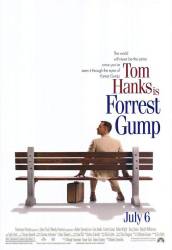Trivia: Disabled U.S. veterans would tell Gary Sinise that they were inspired by his portrayal of Lt. Dan in this film. Feeling humbled because he himself was neither a veteran or disabled, he established the Gary Sinise Foundation in order to help disabled veterans adjust to their new lives. https://www.garysinisefoundation.org.
Trivia: Dave Chappelle was originally offered the role of Bubba in Forrest Gump in a pre-production stage. He was concerned that the character was racially demeaning, so he turned down the part. He has since admitted to regretting the decision.
Trivia: Forrest's son is played by Haley Joel Osment, who later achieved great fame as the troubled Cole in the "The Sixth Sense". (02:01:15)
Trivia: In the original script, every member of Forrest's platoon in Vietnam was supposed to have a low IQ. This was an experimental practice of the Army in the Vietnam War; the Army tried allowing soldiers with lower IQs to enlist, but put them all in platoons together. Because this led to so many discipline problems, the Army is not particularly proud of it and threatened not to work with the filmmakers at all if they left the platoon like that. As a result, only Forrest and Bubba are noticeably below average intelligence.
Trivia: When Bubba tells Forrest that his name is Benjamin Buford Blue but people call him Bubba, Forrest was not supposed to respond. However Tom Hanks replied "My name is Forrest Gump. People call me Forrest Gump", and Zemeckis decided to keep it in the film.
Trivia: The park bench that Tom Hanks sits on for much of the movie was located in Savannah, GA, at Chippewa Square. The fiberglass bench he sat on has since been removed and placed into a museum to avoid being destroyed by the weather. The church where the feather first falls is about 100 yards just down the street from his bench.
Trivia: While Forrest is pushing Lt. Dan through the traffic in his wheelchair, the music is from "The Midnight Cowboy". A taxi stops short and Lt. Dan says "I'm walkin' heah, I'm walkin' heah." It was a famous line said by Dustin Hoffman from that movie. (01:16:35)
Trivia: In the beginning of the film when young Forrest is on the School Bus one of the boys that tells him he can't sit down is Director Robert Zemeckis son Alex. (00:12:45)
Trivia: Sally Field plays Tom Hanks' mother in the movie, even though she's only 10 years older than him.
Trivia: The way Forrest Gump was suppose to sound was never actually planned. When Michael Humphreys was cast as the young Forrest, he came from a part of Tennessee which had that unique accent. Tom Hanks then had to copy Michael Humphreys' accent by using tape recorders while in conversation.
Trivia: When Forrest is carrying Bubba as he runs from the napalm, Mykelti Williamson was too heavy for Tom Hanks to carry, so he's on a wire rigged to a crane.
Trivia: When Forrest is meeting President Kennedy, the music playing in the background is from the musical "Camelot." The history of this connection is as follows: In a 'Life' magazine interview (a week after the President's assassination) Jacqueline Kennedy (his widow) compared the Kennedy years (with children Caroline and John Jr.) in the White House to King Arthur's kingdom "Camelot", explaining how fond the President was of listening to the musical Camelot's title song.
Trivia: Tom Hanks' scene where he calls the hotel management from his room to report about the "power outage" across the street in the Watergate was actually filmed on scene within the Howard Johnson's hotel which contained the look out room for the burglars and was the place from which the police were called. The hotel is now a dorm for George Washington University. (01:24:05)
Trivia: Before Tom Hanks was cast as Forrest, Bill Murray was interested in the part.
Trivia: The helicopters in the first Vietnam camp scene consist of one helicopter being superimposed many times over. All the helicopters are fake.






Answer: Johnson refers to Lyndon Johnson, the US President.
William Bergquist